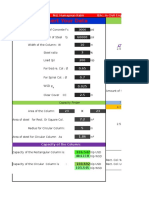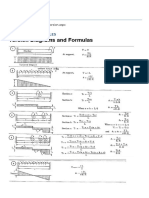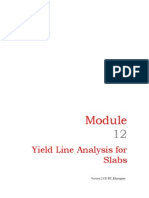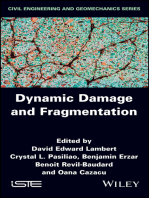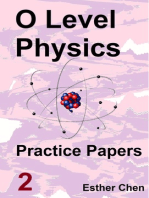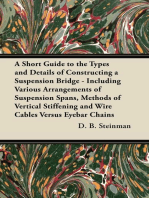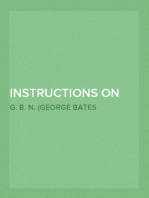12.2. Theoretical Development For Torsion of A Bar
Uploaded by
manmathk12.2. Theoretical Development For Torsion of A Bar
Uploaded by
manmathk12.2.
THEORETICAL DEVELOPMENT FOR TORSION OF A BAR
269
Figure 12.3: material (G) and the polar moment of inertia (J ). With sucient knowledge of these parameters, a shaft can easily be designed to prevent material failure and excessive twisting.
12.2
Theoretical Development for Torsion of a Bar
Consider a long, slender bar with a circular cross-section that is subjected to torsion by applied concentrated and distributed torques as shown below. The x-axis is placed at the centroid of the cross-section.
OD = 3 in 100 in-lb/in 500 in-lb
OD = 2.5 in 1,000 in-lb
x z
12 in
10 in
7 in
8 in
10 in
Figure 12.4: Circular Bar Subjected to Torque Loading The cross-section may be either a solid circular section or a circular tube. The restriction to a circular cross-section is due to the simplied analysis that will be developed herein. An applied torque with a counterclockwise action is considered positive (such as the torque applied at the right end of the bar in Figure 12.4); and such a torque would have a moment (torque) vector pointed in the positive x direction when following the usual right-hand rule. Consider now a section of a bar that has a constant internal torque about the x-axis. An example might be a bar that is xed at its left end and has a torque T applied at its right end as shown below. Cut the shaft as some point x and assume the internal torque is Mt (x).
You might also like
- Dynamic Response of Deepwater Lazy Wave Catenary RiserNo ratings yetDynamic Response of Deepwater Lazy Wave Catenary Riser20 pages
- Designing Well Paths To Reduce Drag and TorqueNo ratings yetDesigning Well Paths To Reduce Drag and Torque7 pages
- Lecture 29 Strut Tie Modeling Example FW 18oct100% (1)Lecture 29 Strut Tie Modeling Example FW 18oct40 pages
- Title: Properties of Steel Self Learning Assessment (Problem Set)No ratings yetTitle: Properties of Steel Self Learning Assessment (Problem Set)14 pages
- Strut-And-Tie Model Design Provisions: Robin G. Tuchscherer, David B. Birrcher, and Oguzhan BayrakNo ratings yetStrut-And-Tie Model Design Provisions: Robin G. Tuchscherer, David B. Birrcher, and Oguzhan Bayrak16 pages
- 06 DesignAndRetroffitingStrategyOfRCBCJoints PDFNo ratings yet06 DesignAndRetroffitingStrategyOfRCBCJoints PDF0 pages
- F 3.7 Reinforcing Existing Beams by Welding: (A) Cover Plate Welded To The BottomNo ratings yetF 3.7 Reinforcing Existing Beams by Welding: (A) Cover Plate Welded To The Bottom1 page
- Seismic Retrofi Tting For Existing R/C Buildings Using Buckling-Restrained Tube-in-Tube Energy Dissipative BracesNo ratings yetSeismic Retrofi Tting For Existing R/C Buildings Using Buckling-Restrained Tube-in-Tube Energy Dissipative Braces8 pages
- Strength of Materials/ Unit 7/ Module 2 Torsion II: Problem SetNo ratings yetStrength of Materials/ Unit 7/ Module 2 Torsion II: Problem Set22 pages
- MET201 Second Series Important QuestionsNo ratings yetMET201 Second Series Important Questions15 pages
- BFC 20903 (Mechanics of Materials) Chapter 6: TorsionNo ratings yetBFC 20903 (Mechanics of Materials) Chapter 6: Torsion26 pages
- Wire Springs, - Flat Springs, or - Special ShapedNo ratings yetWire Springs, - Flat Springs, or - Special Shaped25 pages
- 5972-Article Text PDF-9730-1-10-20130718No ratings yet5972-Article Text PDF-9730-1-10-2013071810 pages
- Yield Line Analysis For Slabs Module12 Lesson30100% (2)Yield Line Analysis For Slabs Module12 Lesson3029 pages
- Beam Theory for Subsea Pipelines: Analysis and Practical ApplicationsFrom EverandBeam Theory for Subsea Pipelines: Analysis and Practical ApplicationsNo ratings yet
- 3D Modeling of Nonlinear Wave Phenomena on Shallow Water SurfacesFrom Everand3D Modeling of Nonlinear Wave Phenomena on Shallow Water SurfacesNo ratings yet
- Dynamic Damage and FragmentationFrom EverandDynamic Damage and FragmentationDavid Edward LambertNo ratings yet
- Hyperbolic Structures: Shukhov's Lattice Towers - Forerunners of Modern Lightweight ConstructionFrom EverandHyperbolic Structures: Shukhov's Lattice Towers - Forerunners of Modern Lightweight ConstructionNo ratings yet
- Electron Beam-Specimen Interactions and Simulation Methods in MicroscopyFrom EverandElectron Beam-Specimen Interactions and Simulation Methods in MicroscopyNo ratings yet
- A Short Guide to the Types and Details of Constructing a Suspension Bridge - Including Various Arrangements of Suspension Spans, Methods of Vertical Stiffening and Wire Cables Versus Eyebar ChainsFrom EverandA Short Guide to the Types and Details of Constructing a Suspension Bridge - Including Various Arrangements of Suspension Spans, Methods of Vertical Stiffening and Wire Cables Versus Eyebar ChainsNo ratings yet
- Engineering Vibroacoustic Analysis: Methods and ApplicationsFrom EverandEngineering Vibroacoustic Analysis: Methods and ApplicationsStephen A. HambricNo ratings yet
- A First Course in Dimensional Analysis: Simplifying Complex Phenomena Using Physical InsightFrom EverandA First Course in Dimensional Analysis: Simplifying Complex Phenomena Using Physical InsightNo ratings yet
- Instructions on Modern American Bridge BuildingFrom EverandInstructions on Modern American Bridge BuildingNo ratings yet
- Mechanical Characterization of Materials and Wave Dispersion: Instrumentation and Experiment InterpretationFrom EverandMechanical Characterization of Materials and Wave Dispersion: Instrumentation and Experiment InterpretationYvon ChevalierNo ratings yet
- Deep Thought: Torsion: A Threat To Mankind !No ratings yetDeep Thought: Torsion: A Threat To Mankind !1 page
- Problem 12.6: 2,200 LB - FT 2 in 8 in PsiNo ratings yetProblem 12.6: 2,200 LB - FT 2 in 8 in Psi1 page
- 12.2. Theoretical Development For Torsion of A BarNo ratings yet12.2. Theoretical Development For Torsion of A Bar1 page
- Axial Load Cell Torsion Load Cell Upper Jaw Grip Circular Rod SpecimenNo ratings yetAxial Load Cell Torsion Load Cell Upper Jaw Grip Circular Rod Specimen1 page
- 12.2. Theoretical Development For Torsion of A Bar: (X + X) (X) (X) (X)No ratings yet12.2. Theoretical Development For Torsion of A Bar: (X + X) (X) (X) (X)1 page
- Free-Body Cut: X Direction On The Left Face (TorqueNo ratings yetFree-Body Cut: X Direction On The Left Face (Torque1 page
- 12.2. Theoretical Development For Torsion Of A Bar: y a a u u φ θ r u a a y y a φ aNo ratings yet12.2. Theoretical Development For Torsion Of A Bar: y a a u u φ θ r u a a y y a φ a1 page
- Stress and Deformation Analysis of Linear Elastic Bars in TorsionNo ratings yetStress and Deformation Analysis of Linear Elastic Bars in Torsion1 page
- z a u u a φ: u u u - Strains (Kinematics)No ratings yetz a u u a φ: u u u - Strains (Kinematics)1 page





